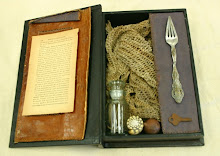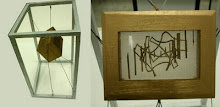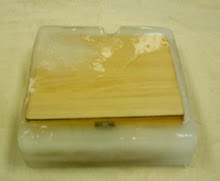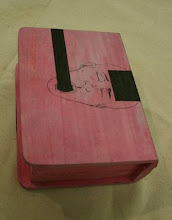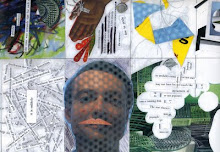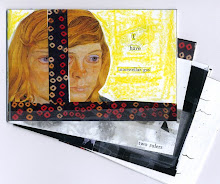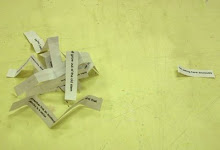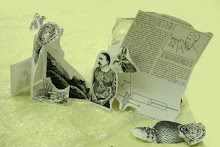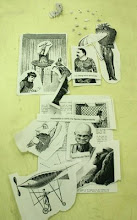VVP: Art 434 & Engl. 410
- Dan Callis and Chris Davidson
- Website for Vision Voice and Practice: An Interdisciplinary Course in Art and Creative Writing
Friday, February 26, 2016
Text/Image Collaboration
We did our first extended collaboration project. Broke the class up into small collaborative teams of visual artist and writers. The project was to create a new thing using text and image privileging the text and text site. Really strong work with the groups exploring the text sites of books, menus, medication labels and greeting cards.
Saturday, February 20, 2016
Ghost Streets of L.A.
Sometimes collaboration is unplanned and hard to see until you're given a different, elevated perspective.
Thursday, February 18, 2016
Text / Image Spot Collaboration
The students we paired off and given a set of random images and text. They were given 20 mins. to "make a new thing" using image and text. Here are a few samples of what was made.
Tuesday, February 16, 2016
Marc Maron & Chris Hayes
MM: Have you thought about that, you know, what the arts actually do and what their place is?
CH: I have, I mean my mom worked in the arts and was an arts administrator, and [she] worked for this non-profit in the arts. I think for me personally the most important training I got for my life was through the theater I did in high school and college.
MM: Really? How so?
CH: A huge part of adult life, the two biggest things about adult life, I find: It's presentation, like, occupying your space, standing and looking someone in the eyes, delivering to them. And collaboration, working with other people to make a thing work. And, we had this student-run theater at Brown where we, you know, we controlled the building, and we'd have these long meetings, where we'd decide, [we had] all these applications, and we'd fight over who's gonna get the space for the next show. That was closer to adult life than to any other thing I did in my four years at a great university. Because it was just about the basic mechanics of group decision-making and collaboration. And so I think that this is in some ways a practical argument for how important the arts are, but I just think [that] every kid should have that awakened in them--
MM: The creativity and the collaboration?
CH: The creativity, the collaboration, the sense of, like, I can make a thing with my friends...and how do we do that, and how do we skirt around conflict? How do you win an argument in a room? You know, those were meetings--the least glamorous part of the arts--but also for me the most instructive.
MM: I understand what you're saying about collaboration and arts, but there's also something about the freedom of expression, on an individual basis. I hear what you're you learned, but I always wonder--you know, people get so self involved, and not entitled, but everyone's expecting to win the lottery or be the next genius. And there's not a lot of attention paid to the act of expressing yourself.
CH: That is--yes. The difference between doing a thing because it will get recognition, and doing a thing because that thing expresses something or fulfills you--it is so hard in a media landscape that is in a very literal fashion built upon the endorphin rush of the ping of recognition.
--from WTF, episode 628, with some elisions and clarifications for readability
CH: I have, I mean my mom worked in the arts and was an arts administrator, and [she] worked for this non-profit in the arts. I think for me personally the most important training I got for my life was through the theater I did in high school and college.
MM: Really? How so?
CH: A huge part of adult life, the two biggest things about adult life, I find: It's presentation, like, occupying your space, standing and looking someone in the eyes, delivering to them. And collaboration, working with other people to make a thing work. And, we had this student-run theater at Brown where we, you know, we controlled the building, and we'd have these long meetings, where we'd decide, [we had] all these applications, and we'd fight over who's gonna get the space for the next show. That was closer to adult life than to any other thing I did in my four years at a great university. Because it was just about the basic mechanics of group decision-making and collaboration. And so I think that this is in some ways a practical argument for how important the arts are, but I just think [that] every kid should have that awakened in them--
MM: The creativity and the collaboration?
CH: The creativity, the collaboration, the sense of, like, I can make a thing with my friends...and how do we do that, and how do we skirt around conflict? How do you win an argument in a room? You know, those were meetings--the least glamorous part of the arts--but also for me the most instructive.
MM: I understand what you're saying about collaboration and arts, but there's also something about the freedom of expression, on an individual basis. I hear what you're you learned, but I always wonder--you know, people get so self involved, and not entitled, but everyone's expecting to win the lottery or be the next genius. And there's not a lot of attention paid to the act of expressing yourself.
CH: That is--yes. The difference between doing a thing because it will get recognition, and doing a thing because that thing expresses something or fulfills you--it is so hard in a media landscape that is in a very literal fashion built upon the endorphin rush of the ping of recognition.
--from WTF, episode 628, with some elisions and clarifications for readability
Marianne Moore & Constraint
Each time we've taught this course, we've paired artists and writers together who we hope will help students see how shared, or similar, sensibilities manifest themselves differently in visual and alphabetic texts, respectively. One of these pairs is the artist Joseph Cornell and the poet Marianne Moore, both of whom work within tight constraints--for Cornell, the box; for Moore, the syllabically bound line and stanza. These constraints reflect biographical realities for both artists, as well as philosophical commitments, something Jennie-Rebecca Falcetta describes, in an essay about Moore and Cornell: "[B]oth made inspired use of bounded microcosms as metaphors for their real-world ideals." One of those microcosms is found in Moore's poem "The Fish," which we asked students, over the weekend, to read--preferably out loud, preferably more than once.
The microcosm of that poem is not only the surreally imaged underwater world it depicts, bound by "the iron edge / of the cliff," but the delicate, and quite rigidly made, ecosystem of the form within which the expressive life of sentences reside. Here are the opening stanzas (the title provides the first words of the first sentence):
The Fish
wade
through black jade.
Of the crow-blue mussel-shells, one keeps
adjusting the ash-heaps,
opening and shutting itself like
an
injured fan.
The barnacles which encrust the side
of the wave, cannot hide
there for the submerged shafts of the...
(Read the rest here.)
To help our students understand the material qualities of the language Moore uses, and of the language they use everyday, we asked them to work together or alone to make imitations of "The Fish," using the same syllable count and end-rhymes as the poem. Here is some of what they made:
The Brand
Grab
A logo's drab
location at the front of the brain
settle soft tissue plane,
manifesting business destiny.
Par-
ty of car
drivers slapped with something to eat,
Wear, watch, love, look, see, meet
the farmers you want to have relations with —
through
"distressed new"
both dichotomy and
architecture, trending
priced by dollar store sticker tags.
Cir-
cle of serv-
ices elegantly formed in
primordial vision:
burrito that sounds so good right now.
— Jared Sumners, Jenna Schmidt
~
- Jesse Fowler
~
Coffee
drink
helps you think.
strong and black, or light and sugary --
coffeehouse creamery
waking up your brain to start the day
when
once again
you don't want to get up but have to.
The pot grumbles to you
that you're late already, so get up.
Dew
golden hue,
percolating, French-roast dirt-water
drips as you pour, hotter
on hand than in cup or on the floor.
Rise ,
Oh surprise!
The mild drug has done its duty of
enabling you to love
the world and people you see and meet.
- Abby Blake, Hannah Brown, Melanie Kim
~
- Megan Brady, Sharayah Hooper
~
The Dress
sways
through the haze
as the evening approaches. The dark-
ening woods leave their mark
on her pale, luminescent features.
She
runs from the
evil which follows her everywhere.
Her feet, the dress, her hair
entangle with elements of
fear.
They draw near
As they hear the thief in the moonlight.
- Jill White, Alessi Debartolo, Olivia O'Brien
~
Drawn,
but almost gone.
Constellations arranged the order
to give the disorder
of sleep upon clementine bedsheets.
Orange
in college
brought inside from a childhood memory.
Outside common reverie;
the bright mass to be mounted upon the wall.
- Destiny Gough, Krystyny Vandenberg, Jessica Dueker
~
The Pack
worn
with much borne.
Secrets carried on sleepy shoulders,
books and bulging folders.
Threadbare canvas carries a life’s work.
- Annika Tuttle, Katie Tuttle, Megan Van Vlear
~
The Bees
buzz
with black fuzz.
delivering a pollen package
like mailmen with baggage,
making hexagon cubicles as
a
stow away.
For calling you pudgy faced, you sting
and with attack, you bring
burning and suicidal death. You
die;
you can't fly.
- Jordan Wilson, Hope Daley, Dani Isaacs
The microcosm of that poem is not only the surreally imaged underwater world it depicts, bound by "the iron edge / of the cliff," but the delicate, and quite rigidly made, ecosystem of the form within which the expressive life of sentences reside. Here are the opening stanzas (the title provides the first words of the first sentence):
The Fish
wade
through black jade.
Of the crow-blue mussel-shells, one keeps
adjusting the ash-heaps,
opening and shutting itself like
an
injured fan.
The barnacles which encrust the side
of the wave, cannot hide
there for the submerged shafts of the...
(Read the rest here.)
To help our students understand the material qualities of the language Moore uses, and of the language they use everyday, we asked them to work together or alone to make imitations of "The Fish," using the same syllable count and end-rhymes as the poem. Here is some of what they made:
The Brand
Grab
A logo's drab
location at the front of the brain
settle soft tissue plane,
manifesting business destiny.
Par-
ty of car
drivers slapped with something to eat,
Wear, watch, love, look, see, meet
the farmers you want to have relations with —
through
"distressed new"
both dichotomy and
architecture, trending
priced by dollar store sticker tags.
Cir-
cle of serv-
ices elegantly formed in
primordial vision:
burrito that sounds so good right now.
— Jared Sumners, Jenna Schmidt
~
The Bird
fights
day and night
to keep the chicks always so safe,
as they hide from the waves
of the other birds
looking for homes.
The
bird’s eyes flee
from place to place, in search of
food and
enemies that may stand
between him and the
chicks needing care.
The
bird’s wings
speed
through the air, with the wind down
under,
like when the Wright brothers
changed the sky, giving
men bird’s-eye views.
The
bird’s feet
leave
the ground after hugging some
unlucky
now-dead life. Luckily,
the chicks can eat to
live like the bird.
- Jesse Fowler
~
Coffee
drink
helps you think.
strong and black, or light and sugary --
coffeehouse creamery
waking up your brain to start the day
when
once again
you don't want to get up but have to.
The pot grumbles to you
that you're late already, so get up.
Dew
golden hue,
percolating, French-roast dirt-water
drips as you pour, hotter
on hand than in cup or on the floor.
Rise ,
Oh surprise!
The mild drug has done its duty of
enabling you to love
the world and people you see and meet.
- Abby Blake, Hannah Brown, Melanie Kim
~
WAFFLES
bake
as we make
up after our heated argument,
ignoring what we meant
when we said we couldn’t
go on.
Ding!
It’s burning.
As smoke is rising from the iron,
“How could I ever earn
your time and your love
and your respect?
box-
ed, gridlock-
ed, I am syrup in a divot.
You’re an iron rivet.
So, eat up—that’s what I am
here for.”
- Megan Brady, Sharayah Hooper
~
The Dress
sways
through the haze
as the evening approaches. The dark-
ening woods leave their mark
on her pale, luminescent features.
She
runs from the
evil which follows her everywhere.
Her feet, the dress, her hair
entangle with elements of
fear.
They draw near
As they hear the thief in the moonlight.
- Jill White, Alessi Debartolo, Olivia O'Brien
~
Drawn,
but almost gone.
Constellations arranged the order
to give the disorder
of sleep upon clementine bedsheets.
Orange
in college
brought inside from a childhood memory.
Outside common reverie;
the bright mass to be mounted upon the wall.
- Destiny Gough, Krystyny Vandenberg, Jessica Dueker
~
The Pack
worn
with much borne.
Secrets carried on sleepy shoulders,
books and bulging folders.
Threadbare canvas carries a life’s work.
- Annika Tuttle, Katie Tuttle, Megan Van Vlear
~
The Bees
buzz
with black fuzz.
delivering a pollen package
like mailmen with baggage,
making hexagon cubicles as
a
stow away.
For calling you pudgy faced, you sting
and with attack, you bring
burning and suicidal death. You
die;
you can't fly.
- Jordan Wilson, Hope Daley, Dani Isaacs
Saturday, February 6, 2016
And so it begins!
What does it mean?
A natural questions after spending 30 mins. of class time making these little
things. We are by nature “meaning mongers” as Walker Percy describes us. We
work to make sense of our world.
We made and we talked. We talked about meaning making, about
text and image as distillation and expansion. We talked about text and image as
a social embodiment requiring submission, patience, and love.
Working with a page of random blocks of sampled internet
text, a pair of scissors, and some tape the students worked in pairs for 30 mins. to “make a thing. a thing with
meaning.” Here are a few examples of those “things.”

-->
Subscribe to:
Comments (Atom)





































































































